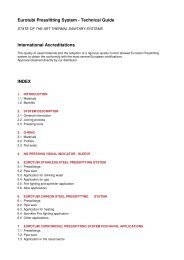Vis PDF - Damstahl
Vis PDF - Damstahl
Vis PDF - Damstahl
Create successful ePaper yourself
Turn your PDF publications into a flip-book with our unique Google optimized e-Paper software.
Technical<br />
information<br />
Chapter 5: Ferritic, Stainless Steel<br />
Magnetism, Thermal Elongation and Wear<br />
Magnetically, the ferritic stainless steels resemble mild steel. All ferritic stainless steels are strongly<br />
magnetic while the nickel containing austenites are either non-magnetic or, in the case of cold<br />
working, slightly magnetic.<br />
Also with respect to thermal properties, the ferritic stainless steels are closer to the carbon steels<br />
than the austenites. The thermal elongation of the ferrites is about 30-35 % lower than that of the<br />
austenitic types thereby reducing the risk of deformation during welding or subsequent operation.<br />
This is particularly important if the equipment is to be made from both stainless steel and mild<br />
steel as the thermal tension in between the mild steel and the austenitic steel is larger than in between<br />
the mild steel and the ferrites.<br />
With regard to wear, stainless steel against stainless steel has a nasty habit of adhesive wear. This<br />
risk may be reduced by choosing two different types of stainless steel (i.e. with two different grain<br />
structures). A ferrite against an austenite is a better wear combination than austenite against austenite,<br />
although still inferior to well-known combinations as, say, bronze against stainless steel.<br />
Welding of Ferritic Stainless Steel<br />
In contrast to previous teachings, it is perfectly possible<br />
to weld ferritic stainless steels, although they<br />
are less foolproof than the austenites. The lack of Ni<br />
increases the risk of grain growth and the formation<br />
of unwanted phases as a result of the heating. Such<br />
effects may cause brittleness and reduced corrosion<br />
resistance, and therefore, one has to be more careful<br />
when welding the ferrites as compared with the austenites,<br />
in particular with regard to the heat input.<br />
The thicker the steel, the more important it is to<br />
keep the heat input low in order to avoid unwanted<br />
side effects.<br />
This said, the present-day ferritic steels are much<br />
easier to weld than the past generations of steel.<br />
Welded sample of ”acid resistant” ferritic 4521. Thickness:<br />
2 mm; method: TIG; filler metal: AISI 316LSi;<br />
current: 90 A; and purge gas: pure Ar.<br />
This is due to the fact that the higher alloyed ferrites are “stabilized” by adding titanium (Ti) and/or<br />
niobium (Nb), both of which stabilize against grain growth during welding. It is essential to employ<br />
stabilizers in sufficient quantities, e.g. Ti and/or Nb, both strong carbide formers and blocking grain<br />
growth. Thereby, chromium carbides are unable to form during the thermal cycles of welding.<br />
Unstabilized ferritic grades, such as 4016, can therefore be susceptible to intergranular corrosion in<br />
the HAZ due to chromium carbide formation. For this reason, the non-stabilized types, such as 4003<br />
and 4016, are not recommended for welding without a subsequent heat treatment.<br />
301<br />
www.damstahl.com<br />
01.2013
















